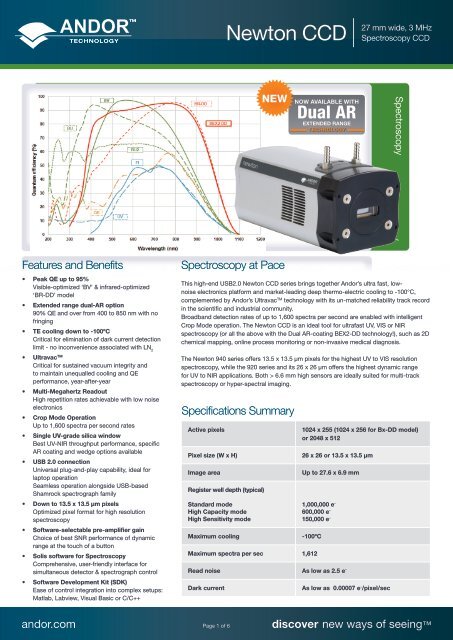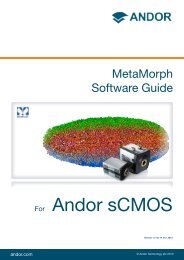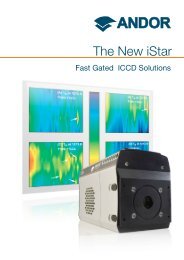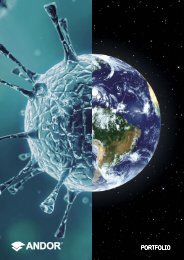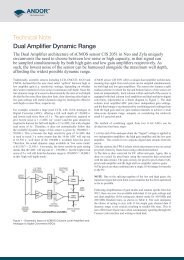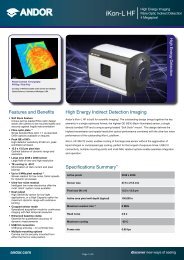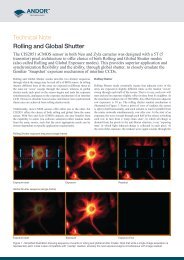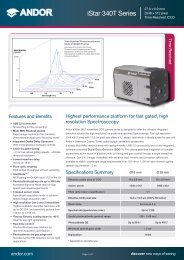Newton CCD - Andor Technology
Newton CCD - Andor Technology
Newton CCD - Andor Technology
Create successful ePaper yourself
Turn your PDF publications into a flip-book with our unique Google optimized e-Paper software.
Features and Benefits<br />
• Peak QE up to 95%<br />
Visible-optimized ‘BV’ & infrared-optimized<br />
‘BR-DD’ model<br />
• Extended range dual-AR option<br />
90% QE and over from 400 to 850 nm with no<br />
fringing<br />
• TE cooling down to -100ºC<br />
Critical for elimination of dark current detection<br />
limit - no inconvenience associated with LN 2<br />
• Ultravac TM<br />
Critical for sustained vacuum integrity and<br />
to maintain unequalled cooling and QE<br />
performance, year-after-year<br />
• Multi-Megahertz Readout<br />
High repetition rates achievable with low noise<br />
electronics<br />
• Crop Mode Operation<br />
Up to 1,600 spectra per second rates<br />
• Single UV-grade silica window<br />
Best UV-NIR throughput performance, specific<br />
AR coating and wedge options available<br />
• USB 2.0 connection<br />
Universal plug-and-play capability, ideal for<br />
laptop operation<br />
Seamless operation alongside USB-based<br />
Shamrock spectrograph family<br />
• Down to 13.5 x 13.5 µm pixels<br />
Optimized pixel format for high resolution<br />
spectroscopy<br />
• Software-selectable pre-amplifier gain<br />
Choice of best SNR performance of dynamic<br />
range at the touch of a button<br />
• Solis software for Spectroscopy<br />
Comprehensive, user-friendly interface for<br />
simultaneous detector & spectrograph control<br />
• Software Development Kit (SDK)<br />
Ease of control integration into complex setups:<br />
Matlab, Labview, Visual Basic or C/C++<br />
<strong>Newton</strong> <strong>CCD</strong><br />
Specifications Summary<br />
27 mm wide, 3 MHz<br />
Spectroscopy <strong>CCD</strong><br />
andor.com Page 1 of 6 discover new ways of seeing<br />
Spectroscopy<br />
Active pixels 1024 x 255 (1024 x 256 for Bx-DD model)<br />
or 2048 x 512<br />
Pixel size (W x H) 26 x 26 or 13.5 x 13.5 μm<br />
Image area Up to 27.6 x 6.9 mm<br />
Register well depth (typical)<br />
Standard mode<br />
High Capacity mode<br />
High Sensitivity mode<br />
NEW<br />
Spectroscopy at Pace<br />
1,000,000 e -<br />
600,000 e -<br />
150,000 e -<br />
Maximum cooling -100ºC<br />
Maximum spectra per sec 1,612<br />
NOW AVAILABLE WITH<br />
Dual AR<br />
EXTENDED RANGE<br />
TECHNOLOGY<br />
This high-end USB2.0 <strong>Newton</strong> <strong>CCD</strong> series brings together <strong>Andor</strong>’s ultra fast, lownoise<br />
electronics platform and market-leading deep thermo-electric cooling to -100°C,<br />
complemented by <strong>Andor</strong>’s Ultravac TM technology with its un-matched reliability track record<br />
in the scientific and industrial community.<br />
Broadband detection rates of up to 1,600 spectra per second are enabled with intelligent<br />
Crop Mode operation. The <strong>Newton</strong> <strong>CCD</strong> is an ideal tool for ultrafast UV, VIS or NIR<br />
spectroscopy (or all the above with the Dual AR-coating BEX2-DD technology!), such as 2D<br />
chemical mapping, online process monitoring or non-invasive medical diagnosis.<br />
The <strong>Newton</strong> 940 series offers 13.5 x 13.5 µm pixels for the highest UV to VIS resolution<br />
spectroscopy, while the 920 series and its 26 x 26 µm offers the highest dynamic range<br />
for UV to NIR applications. Both > 6.6 mm high sensors are ideally suited for multi-track<br />
spectroscopy or hyper-spectral imaging.<br />
Read noise As low as 2.5 e -<br />
Dark current As low as 0.00007 e - /pixel/sec
Key Specifications •1<br />
Minimum temperatures •3<br />
Air cooled<br />
Coolant recirculator<br />
Coolant chiller, coolant @ 10ºC, 0.75 l/min<br />
<strong>Newton</strong> <strong>CCD</strong><br />
27 mm wide, 3 MHz<br />
Spectroscopy <strong>CCD</strong><br />
Model number DU920P DU920P Bx-DD DU940P<br />
Sensor options • BU: Back Illuminated <strong>CCD</strong>,<br />
UV-Enhanced, 350 nm optimized<br />
• BU2: Back Illuminated <strong>CCD</strong>,<br />
UV-Enhanced, 250 nm optimized<br />
• BV: Back Illuminated <strong>CCD</strong>,<br />
VIS optimized<br />
• OE: Open Electrode <strong>CCD</strong><br />
• BR-DD: Back Illuminated,<br />
Deep Depletion <strong>CCD</strong> with fringe<br />
suppression.<br />
• BEX2-DD: Back Illuminated,<br />
Deep Depletion <strong>CCD</strong> with<br />
fringe suppression, extended<br />
range dual AR coating<br />
• BU: Back Illuminated <strong>CCD</strong>,<br />
UV-Enhanced, 350 nm optimized<br />
• BU2: Back Illuminated <strong>CCD</strong>,<br />
UV-Enhanced, 250 nm optimized<br />
• BV: Back Illuminated <strong>CCD</strong>,<br />
VIS optimized<br />
• FI: Front Illimindated <strong>CCD</strong><br />
• UV: Front Illimindated <strong>CCD</strong><br />
with UV coating<br />
Active pixels •2 1024 x 255 1024 x 256 2048 x 512<br />
Pixel size 26 x 26 μm 26 x 26 μm 13.5 x 13.5 μm<br />
Image area 26.7 x 6.7 mm<br />
with 100% fill factor<br />
26.7 x 6.7 mm<br />
with 100% fill factor<br />
Cooler type DU<br />
Max spectra per second •4 144 (OE - Full Vertical Bin)<br />
273 (Full Vertical Bin)<br />
1,149 (OE - Crop Mode - 20 rows)<br />
1,612 (Crop Mode - 20 rows)<br />
Advanced Specifications •1<br />
System window type Single quartz window, uncoated.<br />
Various AR coatings & MgF 2 options<br />
available<br />
27.6 x 6.9 mm<br />
with 100% fill factor<br />
andor.com Page 2 of 6 discover new ways of seeing<br />
-80ºC<br />
-95ºC<br />
-100ºC<br />
272 (Full Vertical Bin),<br />
1,587 (Crop Mode - 20 rows)<br />
• BR-DD: Single quartz window,<br />
1° wedge, AR coated on both<br />
sides, optimized at 900 nm<br />
• BEX2-DD: Single quartz<br />
window, 1º wedge, uncoated<br />
Blemish specifications Grade 1 as per sensor manufacturer definition<br />
Dark current, e - /pixel/sec @ max cooling<br />
FI, OE, UV<br />
BU, BU2, BV, UVB<br />
Bx-DD<br />
Register well depth<br />
Standard mode<br />
High Sensitivity mode<br />
High Capacity mode<br />
Have you found what you are looking for?<br />
122 (Full Vertical Bin),<br />
943 (Crop Mode - 20 rows)<br />
Single quartz window, uncoated.<br />
Various AR coatings & MgF 2<br />
options available<br />
Need to work further into the NIR? The iDus InGaAs series, with up to 1024 pixel linear array with transmission to 2.2 μm.<br />
Need a customized version? Please contact us to discuss our Customer Special Request options.<br />
0.0005<br />
0.001<br />
-<br />
1,000,000 e -<br />
-<br />
-<br />
The <strong>Newton</strong> series combines seamlessly with <strong>Andor</strong>’s research grade Shamrock Czerny-Turner spectrographs.<br />
-<br />
-<br />
0.006<br />
1,000,000 e -<br />
-<br />
-<br />
0.0002<br />
0.0009<br />
-<br />
-<br />
150,000 e -<br />
600,000 e -<br />
Area active pixel well depth 140,000 e- 140,000 e- - •5<br />
100,000 e<br />
Read noise (e - ) •6<br />
Standard mode: Typ (Max)<br />
High Sensitivity mode: Typ (Max<br />
High Capacity mode: Typ (Max)<br />
Sensitivity (e - /count)<br />
Standard mode<br />
High Sensitivity mode<br />
High Capacity mode<br />
50 kHz<br />
4 (8)<br />
1 MHz<br />
12 (18)<br />
Adjustable from 2.5 - 10<br />
-<br />
-<br />
3 MHz<br />
20 (30)<br />
50 kHz<br />
4 (8)<br />
1 MHz<br />
12 (15)<br />
Adjustable from 2.5 - 10<br />
-<br />
-<br />
Linearity •7 Better than 99%<br />
Digitization 16 bit<br />
3 MHz<br />
15 (30)<br />
Vertical clock speed •8 Software selectable between 2 - 179 µs<br />
50 kHz<br />
2.5 (4)<br />
9 (12)<br />
1 MHz<br />
7 (12)<br />
27 (32)<br />
-<br />
Adjustable from 1 - 4<br />
Adjustable from 4 -16<br />
3 MHz<br />
11 (15)<br />
40 (56)
Dark Current •9<br />
Typical Setup<br />
PC<br />
Power Supply<br />
<strong>Newton</strong> <strong>CCD</strong><br />
USB 2.0<br />
Software CD<br />
Alternative Detector<br />
(e.g. iDus InGaAs)<br />
Spectrograph<br />
<strong>Newton</strong> <strong>CCD</strong><br />
Quantum Efficiency Curves •10<br />
25°C<br />
Readout Rate & Speed •11<br />
27 mm wide, 3 MHz<br />
Spectroscopy <strong>CCD</strong><br />
NEW<br />
andor.com Page 3 of 6 discover new ways of seeing
Creating The Optimum<br />
Product for You<br />
How to customize the <strong>Newton</strong> <strong>CCD</strong><br />
series :<br />
Step 1.<br />
Simply select from the 2 sensor array<br />
types that best suit your needs from<br />
the selection opposite.<br />
Step 2.<br />
The <strong>Newton</strong> <strong>CCD</strong> comes with 8<br />
options for sensor types. Please<br />
select the sensor which best suits<br />
your needs.<br />
Step 3.<br />
Please indicate if you wish to select<br />
an alternative window and which<br />
software you require.<br />
Step 4.<br />
For compatibility, please indicate<br />
which accessories are required.<br />
<strong>Newton</strong> <strong>CCD</strong> mounted on a<br />
Shamrock 500 mm triple grating<br />
imaging spectrograph, ideal for high<br />
resolution spectroscopy.<br />
Step 1.<br />
Choose sensor array<br />
920P: 1024 x 255 pixel array<br />
1024 x 256 pixel array (BxDD)<br />
940P: 2048 x 512 pixel array<br />
Step 3.<br />
<strong>Newton</strong> <strong>CCD</strong><br />
Choose sensor type<br />
27 mm wide, 3 MHz<br />
Spectroscopy <strong>CCD</strong><br />
Step 2.<br />
BEX2-DD: Back Illuminated, Deep Depletion <strong>CCD</strong> with<br />
fringe suppression and extended range dual AR coating<br />
BR-DD: Back Illuminated, Deep Depletion <strong>CCD</strong> with<br />
fringe suppression<br />
BU: Back Illuminated <strong>CCD</strong>, Blue optimized AR coating for<br />
Spectroscopy<br />
BU2: Back Illuminated <strong>CCD</strong>, AR coated for optimized<br />
performance in the 250 nm region<br />
BV:Back Illuminated <strong>CCD</strong>, Vis optimized<br />
FI: Front Illuminated <strong>CCD</strong><br />
OE: Open Electrode <strong>CCD</strong><br />
UV: Front Illuminated <strong>CCD</strong> with UV coating<br />
The <strong>Newton</strong> <strong>CCD</strong> series models are supplied with an uncoated Quartz window as standard.<br />
BR-DD models are provided with an NIR optimized AR coating. The following alternative<br />
window choices are available and must be ordered at time of build (if selected):<br />
OPTION-C1-AR1 AR coated quartz window (optimized broadband visible 400-900nm).<br />
50% transmission at 180 nm<br />
OPTION-C1-MGF2 Magnesium Fluoride window for transmission in the VUV.<br />
50% transmission at 120 nm<br />
The <strong>Newton</strong> <strong>CCD</strong> also requires at least one of the following software options:<br />
Solis for Spectroscopy A 32-bit application compatible with 32 and 64-bit Windows (XP, Vista<br />
and 7) offering rich functionality for data acquisition and processing. <strong>Andor</strong>Basic provides<br />
macro language control of data acquisition, processing, display and export. Control of <strong>Andor</strong><br />
Shamrock spectrographs and a very wide range of 3 rd party spectrographs is also available, see<br />
list below.<br />
<strong>Andor</strong> SDK A software development kit that allows you to control the <strong>Andor</strong> range of cameras<br />
from your own application. Available as 32 and 64-bit libraries for Windows (XP, Vista and 7)<br />
and Linux. Compatible with C/C++, C#, Delphi, VB6, VB.NET, LabVIEW and Matlab.<br />
Step 4.<br />
The following accessories are available:<br />
XW-RECR Coolant re-circulator for enhanced cooling performance<br />
ACC-XW-CHIL-160 Oasis 160 Ultra Compact Chiller Unit (tubing to be ordered separately)<br />
ACC-6MM-TUBING-2xxxxM 6 mm tubing option for ACC-XW-CHIL-160<br />
LM-C C-mount lens adaptor<br />
LM-NIKON-F C-mount lens adaptor<br />
LMS-NIKON-F-NS25B Nikon F-mount lens adaptor with shutter<br />
ACC-SD-VDM1000 Shutter Driver for NS25B Bistable Shutter (not needed for Shamrock<br />
spectrographs)<br />
ACC-SHT-NS25B Bistable Shutter, Standalone (not needed for Shamrock spectrographs)<br />
Spectrograph Compatibility<br />
DU 920 P- BV<br />
example shown<br />
The <strong>Newton</strong> series is fully compatible with <strong>Andor</strong>’s Shamrock spectrograph (163 - 750 nm focal<br />
lengths) family. Spectrograph mounting flanges and software control are available for a wide<br />
variety of 3 rd party spectrographs including, McPherson (including 1 m and greater focal length<br />
option), JY/Horiba (excluding USB models), PI/Acton, Chromex/Bruker, Oriel/Newport, Photon<br />
Design, Dongwoo, Bentham, Solar TII and others.<br />
andor.com Page 4 of 6 discover new ways of seeing
Product Drawings<br />
Dimensions in mm [inches]<br />
Connecting to the <strong>Newton</strong><br />
Camera Control<br />
Connector type: USB 2.0<br />
TTL / Logic<br />
Connector type: SMB, provided with SMB - BNC cable<br />
1 = Fire (Output), 2 = External Trigger (Input), 3 = Shutter (Output)<br />
I 2 C connector<br />
Compatible with Fischer SC102A054-130<br />
1 = Shutter (TTL), 2 = I 2 C Clock, 3 = I 2 C Data, 4 = +5 Vdc, 5 = Ground<br />
Minimum cable clearance required at rear of camera<br />
90 mm<br />
118.9 [4.68]<br />
94.0 [3.70]<br />
52.0 [2.05]<br />
19.4 [0.76]<br />
n=<br />
position of pixel 1,1<br />
Applications Guide<br />
Absorption/Transmittance/Reflection<br />
Atomic Emission Spectroscopy<br />
Fluorescence & Luminescence<br />
NIR Spectroscopy<br />
118.9 [4.68]<br />
94.0 [3.70]<br />
52.0 [2.05]<br />
19.4 [0.76]<br />
Weight: 2.7 kg [5 lb15 oz]<br />
Raman Spectroscopy (244 – 488 nm)<br />
Raman Spectroscopy (514, 531, 633 nm)<br />
Raman Spectroscopy (785, 830 nm)<br />
UV-VIS-NIR broadband spectroscopy<br />
= Suitable = Optimum<br />
47.0 [1.85]<br />
90.0 [3.54]<br />
101.2 [3.99]<br />
47.0 [1.85] Water connectors Water connectors<br />
2 off 6.0mm internal 2 off 6.0mm internal<br />
diameter soft PVC diameter hose soft PVC hose<br />
90.0 [3.54]<br />
101.2 [3.99]<br />
BU/ BU2<br />
models<br />
45.4 [1.78]<br />
Focal Plane<br />
of Detector<br />
= pixel 1 location = pixel 1 location<br />
BV<br />
models<br />
<strong>Newton</strong> <strong>CCD</strong><br />
BR-DD<br />
models<br />
BEX2-DD<br />
models<br />
25.4 [1.00] 25.4 [1.00]<br />
Mounting hole locations<br />
FI<br />
models<br />
27 mm wide, 3 MHz<br />
Spectroscopy <strong>CCD</strong><br />
3 off 1/4-20 UNC<br />
x 12.5 [0.50] deep<br />
OE<br />
models<br />
UV<br />
models<br />
andor.com Page 5 of 6 discover new ways of seeing<br />
50.0 [1.97]<br />
4 off Ø4.0 [0.16] 4 off Ø4.0 [0.16]<br />
faceplate mounting faceplate holes mounting holes<br />
O'ring Ø54.4 [2.14] O'ring internal Ø54.4 [2.14] internal<br />
45.4 [1.78]<br />
Focal Plane<br />
of Detector<br />
10.0 [0.39]<br />
50.0 [1.97]<br />
10.0 [0.39]<br />
200.3 [7.89]<br />
22.0 [0.87]<br />
Fire SMB<br />
External Trigger SMB<br />
Shutter SMB<br />
200.3 [7.89]<br />
Power<br />
I²C USB 2.0<br />
Rear connector panel<br />
Third-angle projection
Items shipped with your camera:<br />
1x 2m BNC - SMB conection cable<br />
1x 3m USB 2.0 cable Type A Type B<br />
1x Set of Allen keys (7/64”, 3/32” & 3 mm)<br />
1x Power supply with mains cable<br />
1x Quick launch guide<br />
1x CD containing <strong>Andor</strong> user guides<br />
1x Individual system performance booklet<br />
1x CD containing either Solis software or SDK<br />
(if ordered)<br />
Minimum Computer Requirements:<br />
• 3.0 GHz single core or 2.4 GHz multi core processor<br />
• 2 GB RAM<br />
• 100 MB free hard disc to install software (at least<br />
1 GB recommended for data spooling)<br />
• USB 2.0 High Speed Host Controller capable of<br />
sustained rate of 40 MB/s<br />
• Windows (XP, Vista and 7) or Linux<br />
Operating & Storage Conditions<br />
Operating Temperature 0°C to 30°C ambient<br />
Relative Humidity < 70% (non-condensing)<br />
Storage Temperature -25°C to 50°C<br />
Power Requirements<br />
110 - 240 Vac, 50 - 60 Hz<br />
<strong>Newton</strong> <strong>CCD</strong><br />
Order Today<br />
27 mm wide, 3 MHz<br />
Spectroscopy <strong>CCD</strong><br />
Need more information? At <strong>Andor</strong> we are committed to finding<br />
the correct solution for you. With a dedicated team of technical<br />
advisors, we are able to offer you one-to-one guidance and<br />
technical support on all <strong>Andor</strong> products. For a full listing of our<br />
local sales offices, please see: andor.com/contact<br />
Our regional headquarters are:<br />
Europe Japan<br />
Belfast, Northern Ireland Tokyo<br />
Phone +44 (28) 9023 7126 Phone +81 (3) 3518 6488<br />
Fax +44 (28) 9031 0792 Fax +81 (3) 3518 6489<br />
North America China<br />
Connecticut, USA Beijing<br />
Phone +1 (860) 290 9211 Phone +86 (10) 5129 4977<br />
Fax +1 (860) 290 9566 Fax +86 (10) 6445 5401<br />
Footnotes: Specifications are subject to change without notice<br />
1. Figures are typical unless otherwise stated.<br />
2. Edge pixels may exhibit a partial response.<br />
3. Cooling is provided by the use of an external mains driven power supply. Minimum<br />
temperatures listed are typical values with ambient temperature of 20°C. Systems are specified<br />
in terms of minimum dark current achievable rather than absolute temperature.<br />
4. Based on horizontal pixel readout rate of 3 MHz and a vertical shift speed of 12.9 μs (920<br />
models), 14.5 µs (940 models) and 25.7 µs (OE model).<br />
Achievable spectral rates will vary with selected trigger mode. Due to the nature of the Open<br />
Electrode sensor, the minimum Vertical Shift Speed (VSS) available is 25.7 µs, which will<br />
produce a lower maximum spectral rate compared to other models in the series.<br />
5. Shown for High Capacity mode. For High Sensitivity mode the measurable well depth value will<br />
be lower, as a result of the combination of higher sensitivity values and A/D 16 bits digitization.<br />
6. Readout noise is for the entire system. It is a combination of <strong>CCD</strong> readout noise and A/D noise.<br />
Measurement is for Single Pixel readout with the <strong>CCD</strong> at a temperature of -80°C and minimum<br />
exposure time under dark conditions. Noise values will change with readout mode.<br />
7. Linearity is measured from a plot of counts vs exposure time under constant photon flux up to<br />
the saturation point of the system.<br />
8. Vertical speeds are software selectable. All sensors are designed to give optimum Charge<br />
Transfer Efficiency (CTE) at 12.9 μs (920 models), 14.5 µs (940 models) and 25.7 µs (OE model)<br />
vertical pixel shift, some decrease in CTE may be observed at faster shift speeds.<br />
9. The graph shows typical dark current level as a function of temperature. The dark current<br />
measurement is averaged over the <strong>CCD</strong> area excluding any regions of blemishes.<br />
10. Quantum efficiency of the sensor at 20°C as measured by the sensor manufacturer<br />
11. The chart shows the maximum possible readout rates available when using Multi-track mode,<br />
each track being defined as 20 rows. Crop mode is a specific single-track readout method<br />
optimized for rapid kinetic-type acquisition.<br />
Windows is a registered trademark of Microsoft Corporation.<br />
Labview is a registered trademark of National Instruments.<br />
Matlab is a registered trademark of The MathWorks Inc.<br />
S<strong>Newton</strong><strong>CCD</strong>SS 1112 R1<br />
andor.com Page 6 of 6 discover new ways of seeing


